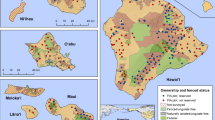Abstract
As urbanization expands into rural areas, an increase in the number of non-native plant species at the urban-rural interface is expected due in large part to the increased availability of propagules from ornamental plantings. A study investigating the distribution of non-native plants in the understories of riparian forests across an urban-to-rural gradient north of Columbus, GA was initiated in 2003. A significantly greater number of non-native plant species occurred at the urban sites and at one site at the urban-rural interface, where 20 to 33% of the species encountered were non-native. In contrast, at the more rural sites non-native species comprised 4–14% of the total number of species. However, the importance values of non-native species as a whole did not change significantly across the land use gradient due to the high frequency and abundance of three non-native species (Ligustrum sinense, Lonicera japonica, and Microstegium vimineum) in the majority of the watersheds. Reductions in species richness and overstory reproduction associated with these non-natives could impact long-term forest structure and ecosystem function.
Similar content being viewed by others
References
Causton, D.R. (1988) Introduction to Vegetation Analysis. Unwin Hyman Ltd., London, 342 p.
Cowell, C.M. (1998) Historical change in vegetation and disturbance on the Georgia Piedmont. American Midland Naturalist 140, 78–89.
D’Antonio, C.M. and Mack, M. (2001) Exotic grasses potentially slow invasion of an N-fixing tree into a Hawaiin woodland. Biological Invasions 3, 69–73.
Guntenspergen, G.R. and Levenson, J.B. (1997) Understory plant species composition in remnant stands along an urban-to-rural land-use gradient. Urban Ecosystems 1, 155–169.
Kowarik, I. (1995) Time lags in biological invasions with regard to the success and failure of alien species. In Plant Invasion—General Aspects and Special Problems. (P. Pysek, K. Prach, M. Rejmanek, and M. Wade, eds.), pp. 15–38. Academic Publishing, Amsterdam.
Lockaby, B.G., Zhang, D., McDaniel, J.M., Tien, H., and Pan, S. (2005) Interdisciplinary research at the urban-rural interface: The WestGa project. Urban Ecosystems 8, 7–21.
Malanson, G.P. (1993) Riparian Landscapes. Cambridge University Press, Cambridge, U.K., 296 p.
Meiners, S.J., Cadenasso, M.L. and Pickett, S.T.A. (2004) Beyond biodiversity: Individualistic controls of invasion in a self-assembled community. Ecology Letters 7, 121–126.
Merriam, R.M. and Feil, E. (2002) The potential impact of an introduced shrub on native plant diversity and forest regeneration. Biological Invasions 4, 369–373.
Miller, J.H. (2003) Nonnative Invasive Plants of Southern Forests: A Field Guide for Identification and Control. Gen. Tech. Rep. SRS-62., 93 p. USDA Forest Service Southern Research Station, Asheville, NC.
Oliver, C.D. and Larson, B.C. (1996) Forest Stand Dynamics, update edition. John Wiley & Sons, Inc., New York, 520 p.
Planty-Tabacchi, A.-M., Tabacchi, E., Naiman, R.J., Deferrari, C. and Decamps, H. (1996) Invasibility of species-rich communities in riparian zones. Conservation Biology 10, 598–607.
SAS Institute, Inc. (1999) SAS OnlineDoc, Version 8, Cary, N.C.
Tu, M. (2002) Elemental Stewardship Abstract for Dioscorea oppositifolia. The Nature Conservancy. http://tncweeds.ucdavis.edu/esadocs.html
With, K. (2002) The landscape ecology of invasive spread. Conservation Biology 16, 1192–1203.
Yurkonis, K.A. and Meiners, S.J. (2004) Invasion impacts local species turnover in a successional system. Ecology Letters 7, 764–769.
Zipperer, W.C. (2002) Urban Influences on Forests. In Human Influences on Forest Ecosystems: The Southern Wildland-Urban Interface Assessment (E.A. Macie and L.A. Hermansen, eds.). Gen Tech. Rep. SRS-64, pp. 73–91. USDA Forest Service, Southern Research Station, Ashville, NC.
Author information
Authors and Affiliations
Corresponding author
Rights and permissions
About this article
Cite this article
Loewenstein, N.J., Loewenstein, E.F. Non-native plants in the understory of riparian forests across a land use gradient in the Southeast. Urban Ecosyst 8, 79–91 (2005). https://doi.org/10.1007/s11252-005-1420-7
Issue Date:
DOI: https://doi.org/10.1007/s11252-005-1420-7




